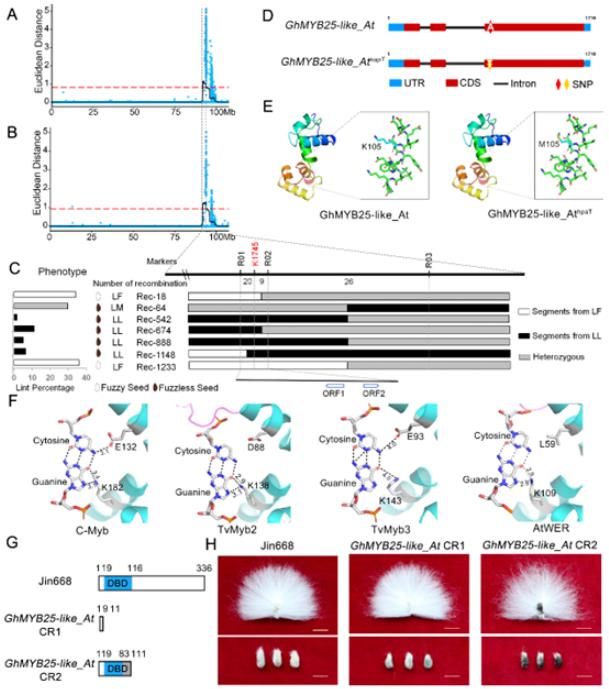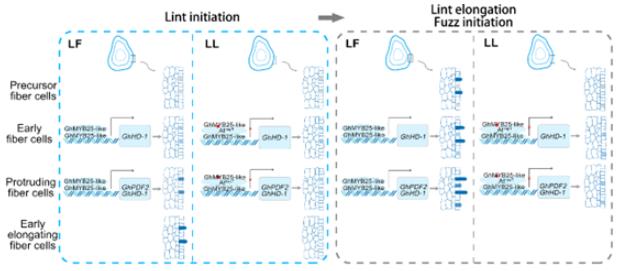Recently, the cotton genetic improvement team of Huazhong Agricultural University published a research paper titled "A dominant negative mutation of GhMYB25-like alters cotton fiber initiation, reducing lint and fuzz" in The Plant Cell. This study illustrates how the key node GhMYB25-like of the fiber initiation regulatory network and its natural mutation GhMYB25-like_AthapT jointly determine the initiation of cotton lint and fuzz through dosage effects and dominant negative effects. This study provides new insights into the initial differentiation and cell fate determination of cotton fiber cells, and provides a theoretical basis for cotton improvement.
Cotton fiber is a single-cell seed hair formed by the protrusions and specialization of ovule epidermal cells. It is an excellent model for studying cell fate determination. Fibers can be divided into two types: lint and fuzz according to the length of mature fibers. The length of lint is long and neat, and it is an important natural textile raw material; the length of fuzz is short and cannot be removed from the seed coat by ginning. During ginning, the friction generated by the contact between the fuzz on the seed surface and the top roller of the gin will cause lint loss. Therefore, breeding cotton varieties without fuzz and with high lint content is of great significance in production. Since the first fiber mutant was reported in 1927, although some sites that control the initiation of lint and fuzz (such as N1, li3, and n2) have been cloned, the molecular mechanism of the action of these sites has not yet been fully elucidated. Moreover, fuzz-free traits are usually closely linked to low lint fraction traits. Therefore, if these loci are to be used in breeding, their genetic basis still needs to be clarified.
In the early stage, the team self-bred the F2 progeny of wild-type Xuzhou 142 and Xuzhou 142 lint-free mutant for 10 consecutive generations, and obtained an inbred line with lint and no fuzz, LM (linted-fuzless). After LM selfing, individuals with three phenotypes, linted-fuzzy (LF), LM and less linted-fuzzless (LL), will be produced, and the segregation ratio conforms to 1:2:1, indicating that the amount of lint and the presence of fuzz are controlled by the same locus in the LM selfing population. The gene corresponding to this site was identified as GhMYB25-like_At, a key transcription factor for fiber initiation, through map-based cloning. A single base mutation (A314T) occurred in the DNA-binding domain of this TF, resulting in a non-synonymous mutation (K105M) in its key amino acid. This mutation was named GhMYB25-like_AthapT.

In order to verify the gene function of GhMYB25-like_At, two CRISPR knockout mutants CR1 and CR2 of GhMYB25-like_At were obtained. GhMYB25-like_At was completely knocked out in the CR1 strain, but the lint of mutant CR1 did not change significantly compared with wild-type Jin668, and only the fuzz was slightly reduced. The editing site of the CR2 strain is on the second exon, producing a non-full-length protein that loses function. However, the lint of the CR2 strain is slightly reduced compared with the wild type, and the fuzz is almost completely eliminated. The fuzz phenotype variation caused by the loss-of-function proteins (GhMYB25-like_AthapT and GhMYB25-like_At CR2) is more obvious than that of the complete knockout protein of the At subgroup (GhMYB25-like_At CR1). Based on the mutant phenotype, it is speculated that GhMYB25-like_AthapT/CR2 may be a dominant negative mutation.
The fiber development process of wild-type LF and mutant LL was compared through single-cell sequencing of the ovule outer integument. It was found that the fiber cells of LL were unable to maintain fiber cell fate, and their development was arrested and unable to protrude. As a core gene of the fiber initiation regulatory network, GhMYB25-like regulates the expression of a series of key fiber initiation genes GhPDF2, CYCD3;1 and PLDs.
Molecular experiments have verified that GhMYB25-like_AthapT/CR2 not only weakens its own ability to activate downstream genes, but also interacts with the wild-type protein GhMYB25-like and inhibits its ability to bind to downstream gene promoters. The above results further prove the dominant negative effect of GhMYB25-like_AthapT/CR2.

In the LM selfing population, the ratio of plants with more lint to those with less lint is 3:1, and less lint is a recessive trait compared to more lint. The ratio of single plants with fuzz to those without fuzz is 1:3, and the lack of fuzz is a dominant trait compared to those with fuzz. This locus shows different dominant and recessive properties in lint and fuzz phenotypes, which is the result of the combined effect of the dosage effect of GhMYB25-like and the dominant-negative effect of GhMYB25-like_AthapT. GhMYB25-like_AthapT inhibits fuzz initiation through a dominant negative effect, but during the lint initiation stage, the dominant negative effect of this site will be diluted by the high abundance of GhMYB25-like protein, causing this mutation to act as a recessive site controlling lint initiation.
Reference:
Zhao, G., et al. A dominant negative mutation of GhMYB25-like alters cotton fiber initiation, reducing lint and fuzz. Plant Cell. 2024 Mar 6: koae068.